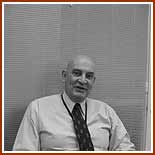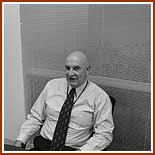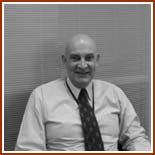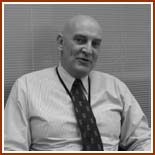 |
|
 "The sheer scale of 1939, the sheer horror of it all, and the loss of life and property grabs peopleís attention."  "You canít stop bushfires in Victoria. They will always be with us to some extent."  "Thatís one of the great lessons that has been presented to us - if you know what to do, you can do a lot to save yourself and save your house."  "The sheer transformation in people and technology from í39 to 2002 is quite incredible."  "I wish Iíd had that opportunity to speak to survivors from the 1939 fires. Iíve been deeply moved by what Iíve heard from people who were exposed to the fires of 2002-2003."  "I spoke to something approaching 450 people, as individuals or groups. That was across the length and breadth of Victoria."  "I think we underestimate the cost of grief to our societies. Not too many years ago, it was wimpy to have debriefing after a particularly horrific situation."  "I was surprised to hear of the survivors of the í39 fires still bursting into tears. A lot of people would have said that time heals all - obviously it doesnít."  "There are situations where it would be foolhardy to think you could survive a fire that was of the size and duration of the 1939 fires."  "I had people come up and put their arm around me and say, "Weíre relying on you". Itís such a powerful transfer of obligation and hope." |
Bruce Esplin Emergency Services Commissioner of Victoria. Head of Bushfire Inquiry, Victoria 2003 
As Commissioner, I have an obligation to provide independent advice to government on any issues relating to emergency management. My role is to ensure the state has an appropriate set of emergency management arrangements. It's also to keep those arrangements under review and to examine them after events to ensure that we learn what went well, what didn't work, what needs to be fixed, and what needs to be modified to improve and strengthen our system. Originally I studied psychology. Dealing with people is the critical issue with my job. It's about relationship management and ensuring all the people who contribute to public safety work as part of an integrated system. The sheer scale of 1939, the sheer horror of it all, and the loss of life and property grabs people's attention. Occurring as it did, following a depression, at the outset of one of the great world wars - the sheer sorrow and loss is incredible. The photos and the paintings I've seen are just horrifying. The Royal Commission into those '39 fires reflects that - it's written in an almost biblical way. It has these 'hell on earth' connotations about it. When you look at what Judge Stretton said in that report, you see the words apathy, and ignorance. There is a seriously implied lack of preparation and lack of prevention activities. There is also great good will, an amazing willingness of people to put themselves out, and volunteers, foresters, people who did great things. But they did them as individuals, not as part of a strong system that's built on prevention, mitigation, and ultimately, suppression. A critical thing Stretton knew, and that we also realise, is that you can't stop bushfires in Victoria. They will always be with us to some extent. I think our inquiry will be partially educative. We want people to understand that you can't prevent fires completely in a continent like this. Certainly in a jurisdiction like Victoria, the terrain and the climatic conditions predispose us to some level of fire activity. We need to learn to live with and manage fire to the best of our advantage. Part of that is about not having a false level of comfort. Some fires will occur, and when they occur we have a management problem, trying to keep them away from the many assets of our communities. Not just houses, not just stock and land and fences, but the environmental and other community assets that make up the rich mix of our contemporary society. We had fires in 1997 that killed three people at Ferny Creek, and I think for the Ferny Creek community, that was a shocking event. We can do a lot about it, largely through a partnership approach by the fire services with their communities. One of the significant changes I've witnessed in the 15 years I've been in the position is fire services seeing themselves as working with their communities to create a safer environment, be it from fire or storm or terrorism or whatever. That is one of the key differences between '39 and 2002-2003. If you look at the scale of the fires in 2003, where the fires burned and how many houses and people were close to those fires, there are not really a lot of houses or lives negatively impacted. There is still too much damage, and we want to fix that. We want to do better next time. But if you go back to '39, in roughly a similar area, lots more houses, lots more structures and, horribly, a lot of people lost their lives. In reading Stretton's report, a lot of people lost their lives doing incredibly stupid things, like burrowing into a heap of sawdust in the expectation that they could escape the flames. There is a far greater community awareness nowadays about the dangers of fire, and what someone can do to help themselves. The Country Fire Authority, for example, has a policy of 'Evacuate early in the day, or stay and fight the fire, if you're prepared and confident to do it'. That's not a policy built on anecdote, it's built on hard data from Black Friday, from Ash Wednesday in '83 and from other serious fires that have taken human lives. The strong finding was that people lose their lives when they evacuate at the last minute. That's one of the great lessons that has been presented to us - if you know what to do, you can do a lot to save yourself and save your house. The initial research from the CSIRO into the Canberra fires suggests that a number of the houses that were lost there probably would have been saved if the person had been there, and had known a little bit about what to do - and had a plan. The personal fire plan is an important thing. There are two changes I see from '39 to now. One is the understanding that prevention and mitigation are critically important. The second is that community participation is an important part of that whole process.  The partnership approach, the network of organisations working together and working with communities is really what it's all about. That's where I think the future opportunities to improve lie, right across the whole spectrum of emergency management. The partnership approach, the network of organisations working together and working with communities is really what it's all about. That's where I think the future opportunities to improve lie, right across the whole spectrum of emergency management.
The communications infrastructure in '39 was nothing like it is today. I noticed to my amazement that Stretton refers to aerial resources, a spotting technology for looking where fires have started. Our use of aerial fire fighting is quite sophisticated, our communications are significantly more sophisticated, and the networking between the various fire fighting organisations is so much stronger. The sheer transformation in people and technology from '39 to 2002-3 is quite incredible. For example, the height of the fires in the north-east of Victoria was on the Australia Day weekend, which was pretty rugged weather-wise. There were over 5000 people from 30 different organisations working in the north-east of the state, and on the same weekend, there were close to 200 other fires, and each one of those other 200 were put out. I think the ability to actually protect towns was greater. If you go back to '39 there is a photo of a person who is standing in the main street in Omeo, and there is nothing left. I've seen a photo from the same spot of Omeo in 2002-2003, and everything is still standing. I think the reason Omeo is still standing after that fire is not because of the fire services, but because the community knew what to do. The fire services had worked with the community to increase their understanding and their awareness and their ability to make a decision. And to me that is the most graphic example of the partnership approach to fire safety in Victoria, and it saved Omeo. I wish I'd had that opportunity to speak to survivors from the 1939 fires. I've been deeply moved by what I've heard from people who were exposed to the fires of 2002-2003. Thank goodness there was no loss of life directly attributable to that fire, but there were people that lost houses or stock or pastures or fences, and that was incredibly traumatic for them. Spending four or five hours in a farm house with 25 people who'd been affected by the fires, hearing their stories and feeling their emotion and anger, is a very powerful and moving experience. It was an issue the bushfire inquiry team had to deal with, because we were taking on board some pretty strong emotions and a pretty palpable anger. Even now, the emotion for us is still real. I can still feel it sitting here and describing it. I think those sorts of emotions are really good and that public policy makers should experience that. I spoke to something approaching 450 people, as individuals or groups. That was across the length and breadth of Victoria, from the far north-west to the far south-east. We spent a lot of time with community people, understanding their views. The basics are that the emergency services and government are there to provide a service for their communities. To provide that service, you need to understand what the communities expect. Sometimes their expectations are not deliverable, and in those situations you need to work with them to make their expectations more achievable. Also you need to boost their own ability, because I think in any emergency situation, there is a period of time where a prepared community member or an individual can make a big difference. Even if a fire truck in an urban area can get there in three minutes, that three minutes is still critical to the ultimate outcome in terms of damage, loss of life, or injury or whatever. One of the things that has changed in a negative sense from '39 to 2002/2003, is that in the built-up areas, there is now a tendency to expect everything to be done for you. There is not so much self-help, and perhaps in some areas not so much willingness to help your neighbours. One of the strong things about rural and regional Victoria is the ability of people to just get out and do it, to look after themselves and their neighbours. They are personality and community traits we need to re-build in the capital cities, because there is an expectation that ringing 000 will provide you with immediate help, and you wont have to do anything to help yourself. The community shouldn't be a passive recipient of services. It can be and should be an active participant in its own safety planning and decision-making.  I look back to '39 and some of the differences between then and now. In the royal commission report, Judge Stretton said those fires were 'lit by the hand of man'. Well, the 2002-2003 fires were lightning strikes. One dry lightning storm over one night caused fires over a very remote part of Victoria. There was a very substantial difference in dealing with lightning strikes compared with dealing with fires that were the result of burn-offs and billies boiling on fires and cigarettes thrown indiscriminately. I look back to '39 and some of the differences between then and now. In the royal commission report, Judge Stretton said those fires were 'lit by the hand of man'. Well, the 2002-2003 fires were lightning strikes. One dry lightning storm over one night caused fires over a very remote part of Victoria. There was a very substantial difference in dealing with lightning strikes compared with dealing with fires that were the result of burn-offs and billies boiling on fires and cigarettes thrown indiscriminately.
There is a bit of a misconception about fuel reduction burning. People think it is a silver bullet or a panacea, the solution to all problems. It's not. It's one part of a toolkit of fire managers, but it has to be very carefully used. It can be very powerful, it might make fires more manageable if you get to them when they are small, but it won't prevent bush fires. It is not a solution for all days, all occasions. The whole point to me is balance, and the contemporary community has to understand that balance. I think we underestimate the cost of grief to our societies. Not too many years ago, probably a decade or so, it was wimpy to have debriefing after a particularly horrific situation. If you were a man, you didn't need that sort of thing. Now that sort of approach has permeated society much more deeply. I was quite surprised to hear of the survivors of the '39 fires still bursting into tears, still wearing that emotion very close to the surface. A lot of people would have made the argument that time heals all - obviously it doesn't. That gives greater weight to the need for people to be able to talk about their experiences fairly soon after emergency situations like this, to at least verbalise them and start the process of understanding them. I've spent hours in a fairly aggressive environment of anger and emotion, but at the end I am continually amazed by the dignity of these people. I believe it is crucial for governments to do more regularly to get back in touch with the people who have been exposed to an emergency situation, and to look back at what we did in the circumstances and what we could do better. It's about learning how we can avoid repeating whatever happened. There are people who for their own agendas have attempted to attribute blame. They did it in '39 and in '83, and they've done it at Ferny Creek. It happens every time. To me, that is one of the most disappointing parts of society now, that immediately after an emergency event, people are looking for someone to blame. There were a tremendous amount of forestry workers in '39 compared to 2002-2003. That changing demographic makes life in Victoria more difficult now in rural and regional communities. The amount of workers on farms in the forests was far greater then, and so were the number of volunteers for the CFA. Now, without those resources, we have to find new ways to provide fire safety in some of the wilder, more remote communities up in the valleys in Gippsland and in the north-east of the state. My understanding of it was that the climatic conditions in the years preceding the '39 fires were not that dissimilar to the conditions before the 2002-2003 fires. Six years of drought, a very dry summer, a number of extreme fire danger days, an extremely dry fuel load throughout the forest. In that sort of situation, some fires are going to be inevitable. Fire will always happen. It's when it takes hold that it becomes a problem. It's a critical challenge for us to identify fire starts, and mobilise our fire fighting resources as quickly as possible. To get to a fire while it is small and put it out. That capability didn't exist in '39. The first difference between the fires then and now is the loss of properties and the loss of lives. That is one argument that says, "Yes, we can do it differently these days". The question becomes, would you ever reach the point that you could stop fires in wildly remote country? If you look at the fire history for the 2002-2003 fires, you'll find there actually were fire fighters who walked six hours to get to a fire, so it's not that different. They were dry fire fighters, who go in there without water, with a back hoe. Now that's not much different to '39.  Being able to access fires in the most wild and remote parts of Victoria is
always going to pose a problem. If you have 87 of them starting within a very
short period of time, then you've got a very big problem. A) you've got to
identify where they all are, and b) you've got to prioritise. Which fires do
you attack first, that are most likely to threaten houses, homes, people, assets? Being able to access fires in the most wild and remote parts of Victoria is
always going to pose a problem. If you have 87 of them starting within a very
short period of time, then you've got a very big problem. A) you've got to
identify where they all are, and b) you've got to prioritise. Which fires do
you attack first, that are most likely to threaten houses, homes, people, assets?
There are situations where it would be foolhardy to think you could survive a fire that was of the size and duration of the 1939 fires. The power it generated is the fundamental reason why the policy of the fire services is to hit a fire quickly, get to it while it is small and you have enough opportunity to actually put it out. A critical part of the strategic thinking of the fire services now is recognition that once a fire is of a substantial size, actually extinguishing it may be impossible. I'd expect that Judge Stretton made a very accurate assessment of why the 1939 fire started. The various causes he describes seem to be most logically what happened. His recommendations seem to be very valid, and in some ways they are not that different to the situation that exists today. It's about coordination, having resources and putting a significant priority on prevention and mitigation - not just hoping you can put fires out when they happen. It's about understanding and working together. The greatest parallel I sense with Judge Stretton is the feeling that it's a privilege to do what we have done. My inquiry team and the two experts who have assisted me, we all see it as a privilege to do what we have done. It's been very intense, very powerful and very upsetting at times, and there have been good times too throughout the course of it, but it is a privilege to do something that you think just might make a difference. I think that's the issue, that if we get it right, it will make a difference. There is also Stretton's objectivity - a desire, without regard for who he might upset, to try and get to the cause of the problem, and make recommendations that might fix the problem. In starting the bushfire inquiry in Victoria, there was a fair amount of media comment about whether I was independent, whether it would be a bureaucratic whitewash. The reality is, in doing an inquiry you will inevitably upset somebody. All you can do is objectively find the facts and make recommendations in relation to those facts. You must have compassion. To understand what service should be provided by the community, you have to understand what impacts the community. But when you come to the recommendations, you have to be in a sense a little bit dispassionate and objective. Stretton was also a poet, and I don't think I can match that. I've done two pieces of wood sculpture that are my method of catharsis, to get it out of my system. I have taken some wood that has been badly burned in the fire and then carved into it to find the fresh, living, highly-polished wood. There's the burned shell and then, as a sign of regeneration and regrowth, the fresh, highly-polished, beautiful-looking timber. I can't be a poet, but I can be a sculptor, I hope. There was one thing that stuck in my mind very strongly when we first started the inquiry. When I was asking professor Enright and Dr Gill whether they'd participate with me as the panel members, I made the mistake of saying that a lot of Victoria has been destroyed. They were very quick to jump on me and say, "A lot of Victoria has been burned, not destroyed". And I think that distinction is a very clear one. Dealing with people, you have to understand that you are going to take a lot on. I had people come up and put their arm around me and say, "We're relying on you". It's such a powerful transfer of obligation and hope. There is also a lot of anger and a lot of issues. The best way of dealing with it is talking about it openly and honestly with the people that you trust to listen to you. You have to talk about it, and I've quite happily talked about it throughout the course of the inquiry. It's put me in touch with a part of myself that had been lost a bit, my love for the country and Victoria. It's given me incredible optimism about the people, and what makes up the people, what sort of characteristics make up Australians. That's resilience, in most cases, a desire and willingness to help each other. And anger when they are fed a line of rubbish - there is a real ability to smell bullshit a million miles away. I hope the work we've done as an inquiry ultimately will be successful, because we're not bullshit, we're there to do a job. Where we've disagreed with what people have said to us, we've told them. We haven't been afraid to go and confront people that are very angry, and go and work with them and listen and argue if necessary.  These are very powerful things, very good things. There is nothing better as a person holding a reasonably senior position in this state to go and really engage with the people I work for. Working with the community has been really good. In the early stages when there was still a lot of recovery work, I was able to go back and talk to various senior people from other departments who have some responsibility for recovery. They were really keen to hear the feedback, positive and negative, and I think that's really healthy. These are very powerful things, very good things. There is nothing better as a person holding a reasonably senior position in this state to go and really engage with the people I work for. Working with the community has been really good. In the early stages when there was still a lot of recovery work, I was able to go back and talk to various senior people from other departments who have some responsibility for recovery. They were really keen to hear the feedback, positive and negative, and I think that's really healthy.
That's one of the strong things I've seen in Victoria's emergency services, that people are prepared and constantly looking for a better way. Emergency management is something that we regard as never being 100 per cent right. We're constantly looking for ways to improve the system. That's the healthiest and strongest attribute that we have, but we need communities to understand that too, that emergencies by definition will never be 100 per cent right. Apathy is a dangerous thing. If you drive around the outer areas of Melbourne at the moment, there is a lot of work that could be done by people in their own properties to make that place safer. But all too frequently, it won't happen. Frequently, after disasters and emergencies, people galvanise into action and do all the right things for a period of time, and then it drops away again. So one of the challenges for government and for emergency services is to keep an appropriate level of awareness and a recognition that it could happen at any time. The second element is to stop thinking, 'What does something cost?' and start analysing, 'What would it cost if this protection is not put in place?'. Changing that thinking is really important. A lot of forces impact on government. What's done in emergency management has to be balanced against education, health, policing and all the other competing bits of government. We need to be in a position where we can say, "Not only can we do this, but we should do it, for these reasons". It really is about balance. It's about communication, and working with communities. We have to plan to prevent and mitigate, not just respond. I think they are the critical issues. Read more about bushfire trauma in the Oral History Section Read more about the bushfires in Canberra in 1939 in the Newspaper section |
The Decision Makers
|
 |